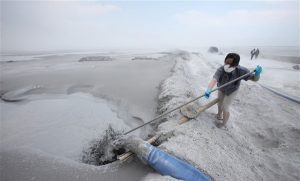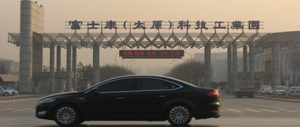China today boasts a collection of 95 environmental courts, all of which were set up over the past six years. It is a trend that promises to re-shape Chinese environmental law.
But simply trumpeting this initiative is no guarantee the environmental courts will live up to their name by making pro-environment decisions. Indeed, initial evidence from Guiyang city in south-west China suggests that ordinary people are pursued by the courts far more often than major polluters are held to task.
With more than a half a decade behind them, it is a good time to take stock of these new institutions. What have they accomplished to date? Can they be an effective tool in China’s fight against pollution? And what does their track record suggest about everyday justice?
Two very different types of court case can help to enforce the law, raise environmental consciousness and scare polluters straight. The first is high-profile litigation that takes on major polluters, for example the lawsuits over mercury and cadmium poisoning that rocked 1960s Japan. In this regard, Chinese environmental advocates have been disappointed by the new courts’ caution. Despite occasional moments of bravery, such as the decision to accept the first lawsuit brought by a government-backed environmental group in 2009, judges are often reluctant to accept cases against big taxpayers, let alone rule against them.
The alternative is the steady trudge of everyday justice; the flow of small decisions that slowly enhance accountability. Often, the barrier to this second route of influence is volume. Most of China’s environmental courts are struggling to find enough cases to justify their existence, especially because environmental lawsuits are fairly rare and the new courts not necessarily well known. Still, a handful of green courts – notably in Wuxi, Guiyang and Chongqing – have broken the hundred-case-per-year barrier.
Everyday justice
In Guiyang, criminal cases have been a large part of the caseload since environmental courts opened there in 2007. To better understand this aspect of the court’s work, I examined 103 publicly available decisions from the Qingzhen District environmental court’s 2010 criminal docket, roughly 80% of the criminal cases that year.
Ninety-two percent of crimes were either accidental fire setting or illegal logging. Reading between the lines, most law-breaking stemmed from poverty, a mistake (fires set by smokers who fell asleep, for example) or bad luck, as seen in a collection of cases in which wind turned an incense-burning ritual at a gravesite into a forest fire.
In this sample at least, the typical environmental criminal had no more than a middle school education and lacked legal representation. He or she was almost certain to be convicted and received an average sentence of 19.6 months if sent to prison.
This sketch of environmental crime raises concerns about justice. Although preventing fires and protecting forests are laudable goals, the extent to which criminal charges are levied against poor rural residents is troubling. The majority of defendants are not hardened polluters, but some of China’s least educated, most disadvantaged citizens.
Though it is too early to say if the pattern seen in Guiyang in 2010 is repeated more widely, there is a fair chance that prosecutors are busier suing small-time rule-breakers than assembling major cases against polluters.
In contrast, most cases in Wuxi and Chongqing are non-litigation administrative execution cases (NAECs) in which government agencies seek court enforcement of their decisions. Sometimes, as Xuehua Zhang has documented in Hubei province, the local environmental protection bureau sees the advantage of adding NAECs to their arsenal. If the bureau wins the case, court orders to freeze company bank accounts or detain top managers can force polluters to pay fines or clean up.
At least in a few places, environmental courts and environmental protection bureaus seem to recognise this potential for mutual gain and strength: a steady supply of cases for the courts and a useful tool for a weak agency often criticised for poor environmental enforcement. NAECs brought by an environmental protection bureau could bring about a symbiotic strengthening of two parts of government responsible for environmental protection, certainly a more encouraging possibility than jailing ordinary people for minor environmental crimes.
Tallying Up
Despite glimmers of future possibilities like this, the early history of China’s environmental courts adds up to an uninspiring start. Although courts often become more assertive over time as they build support in low-level cases before tackling decisions with higher political stakes, they cannot survive if there is no demand for them. Keeping busy is enough for an environmental court to eke out a passing grade for now, in my view, but this will not remain true for long.
How courts spend their time matters and, given the scale of China’s pollution problems, effective environmental courts need to find ways to stop pollution rather than concentrating on natural-resource related crime.
As disappointing as this early history is, it is hardly surprising. Most new institutions struggle to live up to the high hopes of their creators and China’s environmental courts face a particularly challenging political environment.
The Chinese government appears deeply ambivalent about the importance of law, as well as the proper balance between environmental protection and economic growth. Given the climate of political uncertainty, it is little wonder China’s environmental courts are proceeding timidly rather pushing on boldly as so many had hoped.





